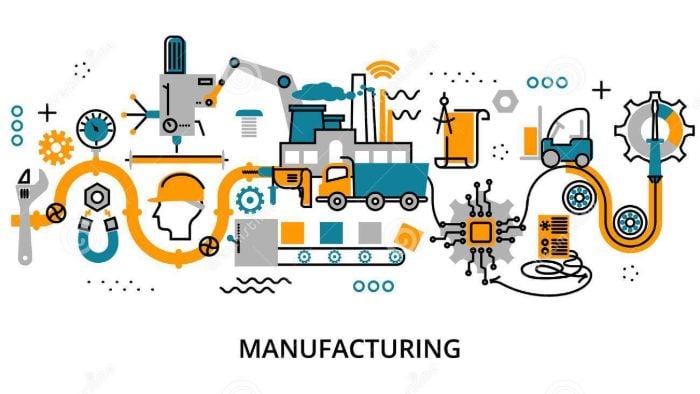You want to invent something, but you have no idea how to manufacture a product. The general steps of the product development process are: developing a unique concept, building a prototype, and finding a reputable manufacturer.
As professionals with ten years of experience in the manufacturing industry, we can help you know how to find manufacturers that are best for you. We’ve guided countless of businesses to start and manufacture their products so we know that these steps are proven and effective.
This article will go through the eight necessary steps of the product development process.

What are manufactured goods, and what are some examples?
Manufactured goods are the end product of primary goods. They are products made by incorporating hard labor and capital into raw materials, turning them into new kinds of goods.
Some examples are:
- Automotive parts and vehicles
Some of the biggest companies with international manufacturers are Toyota Motor Corp and Volkswagen AG.
- Appliances and components
Gree Electric Appliances and Panasonic manufacture products related to appliances and their components.
- Electronic devices
Apple’s iPhones are manufactured by multiple manufacturers and multiple suppliers from different countries.
- Plastics and rubber
Trading companies often trade these products. A trading company can sell plastics and rubbers for small businesses and big ones alike.
Manufactured goods compose great bulks of the exports of Asian countries like China. They generate high-profit returns, so going into the manufacturing industry is compelling. If you want to start your eCommerce business and sell online on your own website or others, then we have the best information you need!
8 Steps of the Manufacturing a Product Process:
Want to start your business but are stuck in the manufacturing process? Don’t worry. You’ve found your way to the right article. Below are the steps I personally take. Follow them and start your journey as an online seller.
Step 1: Develop A Unique Product Concept
Every manufacturing process begins with a unique and relevant product concept. Develop a marketable product idea that can set you apart from competitors. Conduct market research to ensure that you have a spot on the market.
Ask yourself questions like:
- Does this product fulfill a need or fix a problem?
- Will this product sell to my target market even when it’s a small business?
- Will I have little to no direct competition for this product?
- Will I have a decent profit margin?
If the answer is yes to these, we can then proceed with the production process.
You should also think about whether you have enough resources to support your manufacturing costs. Make sure you can afford the raw materials, production costs, labor costs, and custom manufacturing.
Step 2: Build a Prototype
After completing your concept, it’s time to build a prototype. Your prototype needs to visualize your idea as accurately as possible. This is where you show that your idea can, in fact, be turned into a physical good.
Prototypes can be both digital and physical. Other manufacturers can develop the prototype for you, but they are usually expensive. An alternative to this is using tools like:
- Videos and pictures as references
- 3D modeling software
- Hiring freelancers that design products and prototypes
- Using written descriptions
Once you have a prototype, you can proceed to the next step.
Step 3: Find Reputable Manufacturers
Knowing how to manufacture your product is knowing how to find a reputable manufacturing company. As an experienced sourcing agency, we are experts at finding the right potential manufacturers for people like you. Find a manufacturer that can provide for your needs.
These are the variables we consider in finding the best manufacturer:
Reputation: Do they have good reviews? Do they have a manufacturer’s business license? Do they have access to a reliable production line?
Pricing: Does your budget fit the pricing of the manufacturing company? Are there cheaper options?
Quantity: What is their minimum order quantity? Do they transact with smaller quantities?
Capabilities: Have they created custom products like yours? Can they build your physical product with quality? Can they handle mass production?
Overseas VS Domestic Manufacturing Companies

Domestic Manufacturers have a better reputation but higher manufacturing costs.
Overseas manufacturers are less reputable but have a much lower manufacturing cost. They build your products overseas with their partnered supply chain, so there are tariffs and shipping costs to consider as well, though.
Finding the right manufacturing partner will make all the difference. Once you choose whether you want a domestic manufacturer or an overseas manufacturer, then you can move on and ask for quotations. Find a good manufacturer with the best price for your budget.
Looking to find a reliable Chinese supplier?
As the best China sourcing agent, we help you find factories, get competitive prices, follow up production, ensure quality and deliver products to the door.
Step 4: Request Quotations
Start requesting quotations from the several manufacturing companies you found. Ask them to name their price for the product that you need.
When asking for quotations, always be direct and concise. Don’t send several emails talking about one product alone. Include everything that you want them to know in a single message. This will save you time as well as the company.
Three things you should state in your email:
What you need: State that you need a quotation for your product.
Details: Attach your prototype. Tell them as much detail as you want to include. What type of materials do you want them to use? Tell them your production schedules in mind.
How many you need: Tell them the quantity of your order.
Ask at least ten companies if you can. Quoting multiple sources will give you a better sense of the general production price. This prevents you from falling to the tricks of several manufacturers with overpricing schemes.
Step 5: Order a Sample
At this point, you’ve received the quotations that you asked for. Narrow the list to a few manufacturers whose quotes fit your budget. Choose at least two companies you want to try working with.
Order a sample each from the remaining companies you chose. Once your orders arrive, compare them with each other and pick the one that’s made with the best quality.
You will likely still want to make some adjustments to the sample you chose. It’s completely normal! Always give honest feedback. This ensures that your product is of quality.
Step 6: Set Fair Terms
You’ve decided on your manufacturing partner and your final product. The next step is now to negotiate with your actual manufacturer. Here you will discuss your terms about:
Payment: If you’re going to pay 100% upfront investment first or pay half upfront and the rest when you receive your complete order.
Order quantity: See if the number of units you need suits their minimum order quantity. If not, you can always try and negotiate them to reconsider. Companies can adjust their minimum order quantities for some clients if they see fit.
Logistics: Set timelines for the specific milestones of the project. Ask them to provide exact dates when each step of the manufacturing process will be finished.
Step 7: Build A Relationship
This is a very crucial step in knowing how to manufacture a product. Always build a relationship with the right manufacturer! They bring your idea to reality, so you need to cooperate with them and trust each other. You’ll see a significant quality improvement in your product this way.
You might even get free service or finished products if you’re lucky!
Step 8: Lastly, Enjoy Your Manufactured Product!
You finally have your long-awaited final product! You can obtain a patent for your creation if you wish, but it is unnecessary.
5 Tips on how to manufacture a product

Let me share my go-to tips for manufacturing products. Like my clients, you’ll also achieve great success through these tips!
Tip 1: Have quality control when you start producing. Avoid implementing quality control on the final product alone. When flaws are detected late in production, the only way to fix them is to restart the production process again. Avoid wasting money. Have the quality of every component in check beforehand.
Tip 2: Communicate constantly with your manufacturer. Telling them what your general vision is is not enough. Be specific. Be involved in the development process of your own products. Tell the strict dos and don’ts in manufacturing your product.
Tip 3: To save money, adjust designs, not quality. There are several ways for eCommerce entrepreneurs like you to reduce their production costs. Don’t make it happen by reducing the quality of your materials. Adjust your designs and see if there are more efficient ways to build your product.
Tip 4: Use sustainable materials. If you’re planning on having long-term customers with this product, don’t compromise! A manufacturer can sometimes suggest omitting certain materials or designs to make production more efficient. But as mentioned earlier, be aware of your don’ts! Many suppliers and trading companies will offer you cheaper materials but never compromise quality for efficiency. As they say, good things take time.
Tip 5: Think from the customers’ perspective. Sometimes most manufacturers’ ideas won’t align with that of the customer. When in doubt about making some changes, ask opinions from your target market, and see what they think.
Looking for the Best China Sourcing Agent?
Leeline Sourcing helps you find factories, get competitive prices, follow up production, ensure quality and deliver products to the door.
FAQs about how to manufacture a product
What is the world’s largest manufacturing?
According to United Nations Statistics Division, in 2019, China accounted for 28.7% of the world’s total manufacturing output. China has kept its spot ever since it overtook United States’ number 1 spot in 2010.
What is the manufacturing cost of a product?
The product’s manufacturing cost is the total amount of all the resources used that are directly related to creating a product. Find a manufacturer that can work with your manufacturing cost budget.
Why are manufactured products important?
Manufactured products are essential because they boost our economy. Manufacturing leads to innovation, research, and improvement of the global economy.
Do I need a patent to start selling my manufactured products?
Patents are government-issued, exclusive rights and intellectual property to an inventor over a unique, newly developed product or process. Unlike a business license, it is not required by law. You can still sell products without a patent.
What’s Next
Don’t be too intimidated by all the fancy terms! Manufacturing a product can be hard at first, but follow these 8 steps, and you’ll succeed. We go through this process every day, and trust us, it will get easier. Hold on to your unique idea and work your way through finding the right manufacturing partner. Soon, you will have that prototype, and before you know it, you’ll have a finished product in your hand.
We’re Here to Help
If you find it hard to find the right manufacturing companies, kindly visit our service page! We at Lee Line Sourcing have certified professionals who can help you find the best manufacturers for your business anywhere.








